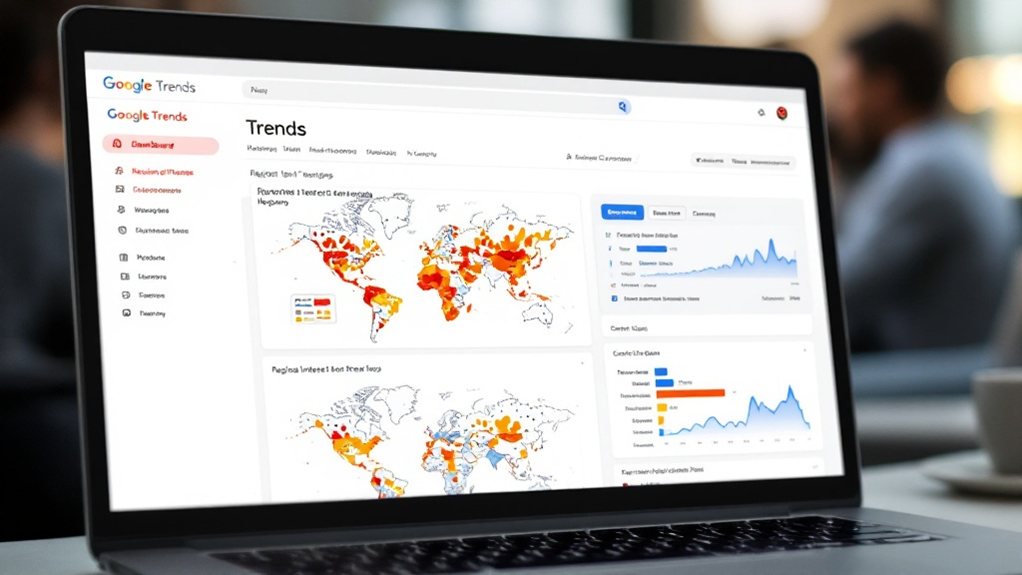Google Trends can provide invaluable geographic insights to refine your content strategy. You can identify high-interest regions, tailor content for local audiences, and optimize for local SEO. Analyze regional search patterns, understand audience needs, and time content releases strategically. Leverage this data to create highly relevant, impactful content that resonates with your target markets. Discover how to put these insights into practice and take your content marketing to the next level.
Leveraging Google Trends for Geographic Insights

How can you leverage Google Trends to gain valuable geographic insights for your content planning? Google Trends provides geographical data to analyze search trends by region, allowing you to tailor your marketing strategies to areas of high interest. Darker shades on the map indicate regions with greater search popularity, helping you identify where your topics resonate most. For some countries, you can even access metro-level data, enabling more precise local analysis. By understanding regional trends, you can adapt your content to address specific local needs and interests, enhancing its relevance. Moreover, Google Trends facilitates cross-regional comparisons, enabling you to detect variations in consumer behavior and identify emerging trends.
Utilizing Regional Interest Maps for Local Content Development

By leveraging the regional interest maps provided by Google Trends, you can gain valuable insights to develop localized content that resonates with your target audiences. The map view allows you to identify "hotspots" of high search interest, which can inform your content strategy. Comparing regional variations helps recognize unique opportunities for tailored content. You can then optimize this local content for SEO, ensuring it reaches the right people. Moreover, the normalized data and time-sensitive insights enable you to plan a content calendar that aligns with evolving regional trends. The API capabilities of Google Trends enable you to extract precise regional search interest data. Ultimately, these geo-specific content strategies can boost your visibility and engagement within targeted localities.
Understanding Audience Needs Through Geographic Analysis

Analyzing regional search trends can uncover valuable insights about your audience's needs and preferences. By identifying emerging trends and patterns across different locations, you can tailor your content to better resonate with local audiences. Leveraging Google Trends data can empower you to create highly relevant and impactful content that addresses the specific interests and pain points of your target markets.
Localized Audience Insights
Understanding the unique needs and preferences of your audience across different regions is crucial for crafting content that resonates effectively. Leverage audience intelligence platforms like Audiense to gain detailed insights into your local audiences – their interests, behaviors, and key influencers. By identifying influential voices in specific locations, you can strategically partner with them to boost your content's reach and relevance. Geographic segmentation allows for highly targeted and personalized marketing campaigns. Additionally, tailoring your products or services to fit regional preferences will increase their market appeal. Closely analyzing location-based audience data also allows you to localize your content, ensuring it aligns with regional language, culture, and interests for a stronger connection.
Tailoring Content for Regions
Effectively tailoring content for specific regions starts with understanding your audience's unique needs and preferences. Use Google Trends' geographic data to identify key cultural and behavioral differences across locations. Incorporating local vernacular, customs, and values can help you to resonate with your target audience. Ensure cultural sensitivity when crafting region-specific content. Tailor your customer journey maps to reflect the nuances of each market, allowing you to create highly relevant pillar and evergreen content. Additionally, leverage regional insights to time your content releases strategically, minimizing competition and maximizing visibility. By aligning your content with regional preferences, you'll enhance engagement and loyalty within your target markets.
Identifying Emerging Trends
Identifying and understanding geographic trends is key to tailoring your content for specific regions. Google Trends' mapping feature allows you to visualize search popularity across different areas. Darker shades indicate higher search volume, enabling you to compare trends and tailor your content to meet local needs. Google Trends data is a real-time dataset of mammoth proportions. Location-specific data provides insights into regional search behaviors, revealing gaps in competitor strategies. Analyze interest by region to understand which topics are trending locally, then leverage this knowledge to create content that resonates with your target audiences. Monitor local rising queries to identify emerging topics and guide your content creation efforts. Leveraging these geographic insights is crucial for creating highly relevant and engaging content for your audience.
Targeting High-Interest Regions for Effective Marketing
By leveraging Google Trends, you can target high-interest regions and craft marketing strategies that resonate with your audience. The tool's location filters enable you to:
- Tailor content and promotions to regional preferences, ensuring maximum engagement.
- Identify opportunities in underserved markets by analyzing competitors' content gaps.
- Time your content releases to coincide with peak interest periods, boosting visibility and impact.
With these insights, you can create geo-specific campaigns that captivate local audiences and give you a competitive edge in your target markets.
Optimizing for Local SEO With Geo-Specific Content
Crafting location-specific content is key to optimizing your local SEO strategy. Leverage Google Trends to uncover regional keyword trends and tailor your content accordingly. By aligning your content with the unique interests and needs of your target audience, you can enhance its relevance and drive better engagement.
Localized Keyword Targeting
As a business looking to optimize for local SEO, you'll find that using Google Trends is an invaluable tool for honing in on the most relevant localized keywords. By analyzing interest by subregion, you can pinpoint geographic areas where your target terms are most popular. Furthermore, the keyword comparison feature allows you to identify the most effective local SEO keywords for your strategy. Targeting local keywords can increase visibility and attract more organic traffic. Don't forget to leverage long-tail keywords and stay on top of market trends to deliver content that resonates with your local audience.
- Identify high-priority local keywords based on search volume and competition.
- Optimize meta descriptions and URLs with localized keywords.
- Regularly monitor Google Trends to adapt your SEO strategy.
Geo-Targeted Content Creation
Geo-targeted content creation is a strategic imperative for businesses seeking to optimize their local SEO presence. By crafting content with specific references to local culture, events, and landmarks, you can resonate with your target audience and boost engagement. Incorporate regional themes, customs, and cultural nuances to personalize your content. Ensure your content is respectful and relevant to local particularities. Leveraging local influencers can deepen audience connection and tap into their existing following. Align your content with local search trends using tools like Google Trends, and focus on specific cities, states, or neighborhoods to target precise audiences. Enhance your local search engine visibility by delivering content that is highly relevant and optimized for user experience.
Discovering Relevant Long-Tail Keywords Through Related Queries
One of the most effective ways to discover relevant long-tail keywords is by exploring the "Related Queries" section in Google Trends. This powerful feature can unveil a treasure trove of long-tail keywords that are gaining traction, allowing you to create content that resonates with your audience.
Some key benefits of exploring related queries include:
- Uncovering Emerging Topics: Identify "rising" queries that indicate emerging trends, enabling you to craft timely, relevant content.
- Boosting Geographic Relevance: Leverage location-specific related queries to tailor your content for targeted regions.
- Refining Keyword Strategies: Compare related queries to refine your long-tail keyword selection and optimize for better search visibility.
Leveraging the "Related Queries" feature in Google Trends is a strategic way to uncover long-tail keywords that can drive your geo-specific content planning.
Identifying and Addressing Seasonal Trends in Search Patterns
Seasonal shifts in search patterns can present valuable opportunities to adjust your content strategy. By analyzing Google Trends data, you can pinpoint when and where demand for certain topics spikes, allowing you to time your content releases for maximum impact. Refreshing evergreen content to capitalize on these cyclical trends can also help sustain visibility and engagement throughout the year.
Seasonal Fluctuations in Search Trends
Understanding seasonal fluctuations in search trends is crucial for effective content planning. Holidays, weather, and cultural events significantly impact search volume, with topics like gifts, recipes, and winter coats spiking during specific seasons. Identifying these trends allows you to:
- Create timely, relevant content that resonates with users' seasonal interests.
- Adjust marketing strategies to align with peaks in demand.
- Leverage affiliate opportunities and strategic promotions driven by seasonal trends.
- Analyze regional variations to develop geo-specific content strategies tailored to local preferences.
Leveraging tools like Google Trends and historical data analysis can provide valuable insights to maximize your content's impact throughout the year.
Optimizing Content for Demand Peaks
Leveraging Google Trends is crucial when optimizing your content for demand peaks. By analyzing seasonal trends, you can identify search behavior patterns around events like back-to-school or the holidays. This allows you to create timely, relevant content that aligns with your audience's interests. Dive into location-specific insights to tailor your content for regional preferences, uncovering untapped opportunities. Capitalize on emerging trends by covering topics before they become saturated, giving you a competitive edge. Integrating Google Trends with other tools like Keyword Planner enhances your data-driven decision-making, ensuring your content matches search volume and feasibility. Finally, prepare seasonal content well in advance to maximize impact during peak periods, leveraging affiliate links and promotions for greater revenue.
Refreshing Evergreen Content Seasonally
As an online publisher, you'll want to pay close attention to Google Trends and other tools that can help you identify evergreen content opportunities with potential for seasonal refreshes. By analyzing seasonal search patterns, you can integrate your evergreen topics with relevant seasonal themes to boost their relevance and performance. Some key strategies include:
- Aligning content with seasonal trends to improve visibility and attract more traffic
- Tailoring content to seasonal needs to boost conversion rates and address specific user queries
- Updating existing content to reflect seasonal trends and user intent changes
Effectively refreshing your evergreen content can differentiate your website and drive cost-effective advertising during peak search periods.
Aligning Content Calendars With Geographic Insights
When aligning your content calendar with geographic insights, you can harness the power of Google Trends to uncover regional trends and tailor your content accordingly. By understanding seasonal peaks, local events, and consumer preferences in specific regions, you can create a more impactful content strategy.
| Regional Trends | Event-Based Content | Localized Branding | Shopping Patterns |
|---|---|---|---|
| Analyze search interest by state, city, or country to identify localized trends. | Plan content around relevant local events to increase engagement. | Enhance your local presence by incorporating regional references and insights. | Time your content publication to align with peak demand periods in specific regions. |
Continuously monitoring these geographic insights and adjusting your content calendar accordingly will help you connect with your audience on a deeper, more personalized level.
Integrating Google Trends Data Into Existing SEO Strategies
Integrating Google Trends data into your existing SEO strategies can amplify your content's relevance and impact across different geographic regions. By complementing your existing SEO tools with real-time Google Trends insights, you can:
- Optimize for long-tail queries and voice searches by identifying emerging search trends in specific locations.
- Analyze competitor visibility and search interest to refine your targeted campaigns and content localization efforts.
- Ensure your content remains relevant by continuously tracking shifts in local search patterns and adjusting your strategies accordingly.
This comprehensive approach empowers you to create highly targeted, geographically-aligned content that resonates with your audience and boosts your online visibility across diverse markets.
Benchmarking Competitors' Geographic Targeting Approaches
By benchmarking your competitors' geographic targeting approaches, you can gain valuable insights to refine your own content strategies and outperform them in specific regions. Compare your brand's search interest to competitors across different locations, identifying their regional strengths and weaknesses. Analyze the popularity of their products and services by region to uncover new opportunities. Study their successful content strategies and see how you can improve upon them for your target markets. Discover which publications and media outlets drive local engagement for your rivals, allowing you to build strategic partnerships and enhance your local presence. This data-driven approach will give you a competitive edge in key geographic areas.
